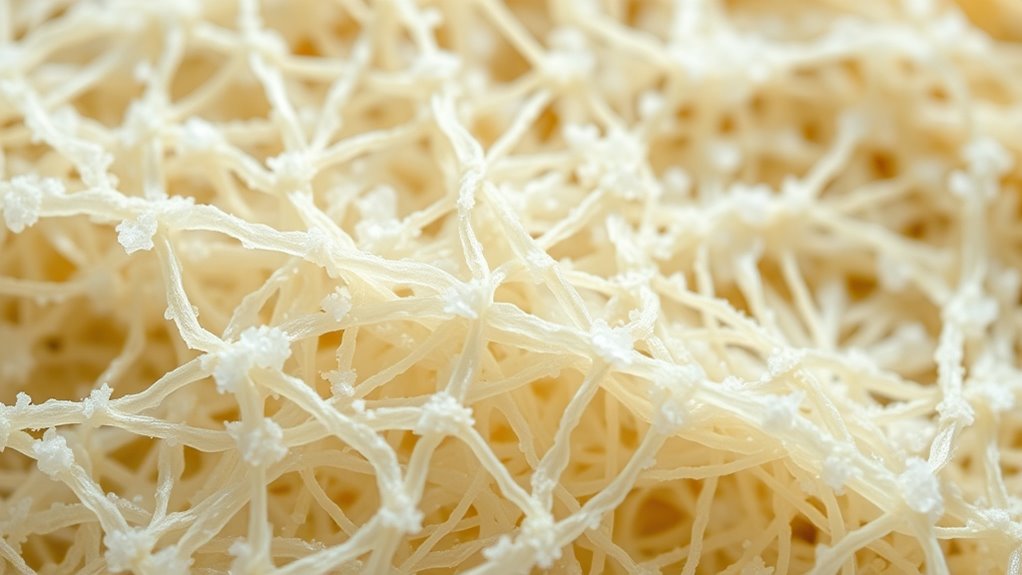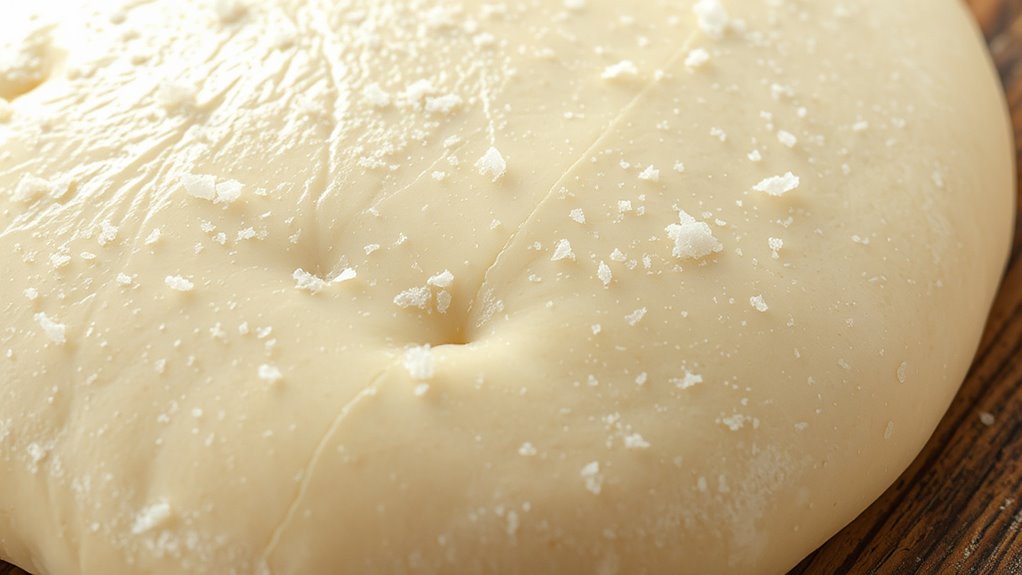Salt strengthens the gluten matrix in dough by dissolving in water and binding to gluten proteins, which helps tighten and reinforce the network. This interaction increases the dough’s elasticity, making it easier to handle and shape without tearing. Proper salt levels balance gluten development, resulting in better crust, chewiness, and dough resilience. By understanding how salt impacts gluten, you’ll improve your baking skills and create more consistent, high-quality baked goods. Keep exploring to learn more about mastering dough strength.
Key Takeaways
- Salt dissolves in dough and interacts with gluten proteins, promoting stronger protein bonds.
- It tightens the gluten network, increasing dough elasticity and resilience during handling.
- Proper salt levels balance gluten development, preventing dough from becoming too tough or weak.
- Salt enhances the dough’s ability to stretch without tearing, improving final bread volume.
- By strengthening the gluten matrix, salt contributes to better dough structure and baked product texture.

Understanding the roles of gluten matrix and salt in dough is fundamental for achieving the perfect bake. When you work with dough, you’re essentially creating a structure that can trap gases, giving your baked goods their rise and texture. At the core of this structure is the gluten network—a web of protein strands formed when wheat flour interacts with water. This gluten network provides the elasticity and strength needed for dough to stretch without tearing, which is indispensable for breads and other baked goods that require a good rise. Without a well-developed gluten network, your dough might be too crumbly or lack the resilience necessary to hold its shape.
Salt plays an important role in strengthening this gluten matrix through its interaction with the proteins. When you add salt to your dough, it dissolves and interacts with gluten-forming proteins, helping to tighten the gluten network. This salt interaction causes the proteins to form stronger bonds, resulting in a dough that’s more elastic and resilient. As a result, your dough becomes easier to handle and shape, and it develops better oven spring because it can stretch further without tearing. Without enough salt, the gluten network remains weak and slack, leading to a dough that’s overly sticky or fragile, which can compromise the final texture of your baked product.
Salt strengthens the gluten network, improving elasticity and resilience for better dough handling and oven spring.
In addition to strengthening the gluten structure, salt also influences the dough’s overall fermentation process. It controls yeast activity, preventing excessive fermentation that could weaken the gluten matrix. By regulating yeast, salt guarantees your dough develops a balanced structure, avoiding overly airy or dense outcomes. The salt interaction with gluten proteins is delicate; too much can make the dough tough and difficult to knead, while too little can result in a weak, underdeveloped gluten network. Striking the right balance is key, and it’s why many bakers measure their salt carefully.
You’ll notice that when you incorporate salt properly, your dough becomes more cohesive and easier to work with. It resists tearing and maintains its shape during shaping and proofing. This improved elasticity directly impacts the final product’s texture, giving you a bread with a chewy crumb and a desirable crust. So, understanding how salt interacts with the gluten network helps you control dough strength and elasticity, leading to more consistent and superior baked goods. Mastering this interaction allows you to craft bread with the perfect balance of structure, flavor, and texture, elevating your baking skills to the next level. Additionally, understanding the gluten matrix can help you optimize your dough development process for various baked goods.
Frequently Asked Questions
Does Salt Affect Gluten Development at Different Baking Temperatures?
You might wonder if salt affects gluten development at different baking temperatures. Salt temperature influences how it interacts with the dough, and it can strengthen the gluten structure by tightening the protein network. At lower temperatures, salt helps improve elasticity, while at higher temperatures, it stabilizes the gluten, preventing overdevelopment. So, yes, salt’s impact on gluten development varies with temperature, helping you achieve the desired dough texture.
Can Salt Replace Other Dough Strengthening Agents?
You might wonder if salt can replace other dough strengthening agents. While salt enhances gluten elasticity, it isn’t a true substitute for ingredients like essential wheat gluten or dough conditioners, which directly strengthen the gluten network. Salt substitutes usually lack these properties. If you’re looking for alternative strengthening agents, consider options like vital wheat gluten or added protein powders, but avoid relying solely on salt for dough strength.
How Does Salt Influence Fermentation Speed and Yeast Activity?
You might notice that salt slows down fermentation rate and yeast activity because it draws moisture away, creating a less hospitable environment for yeast. This coincidence affects how quickly your dough ferments, giving you more control over proofing times. By adjusting salt levels, you influence yeast activity, helping you manage fermentation speed and achieve the perfect rise, especially when baking bread that requires precise timing and texture.
Are There Health Concerns With High Salt Levels in Dough?
You might wonder if high salt levels in dough pose health risks. While salt enhances dough elasticity and flavor, excessive sodium intake can increase blood pressure and heart disease risk. It’s important to balance salt in your recipes and consume processed foods in moderation. By monitoring your sodium intake, you can enjoy tasty baked goods without compromising your health. Always aim for moderation to keep health risks at bay.
Does Salt Impact the Flavor Profile of the Final Baked Product?
Imagine a painter’s palette—salt adds subtle strokes to your baked goods, influencing flavor enhancement and moisture retention. You’ll notice that salt balances sweetness and reduces bitterness, creating a more complex taste. It also helps dough retain moisture, keeping your bread tender and fresh longer. Without salt, your final product might taste flat or bland, like a black-and-white film. So, yes, salt profoundly impacts the flavor profile of your baked masterpiece.
Conclusion
By understanding how salt strengthens the gluten matrix, you can master dough elasticity, improve texture, and achieve perfect results every time. By controlling salt, you control structure; by managing salt, you enhance stretch; by balancing salt, you elevate your baking. So, embrace the power of salt, harness the strength of gluten, and transform simple ingredients into bakery-quality creations. Because with salt and gluten working together, your dough becomes more resilient, more flexible, and more delicious.









